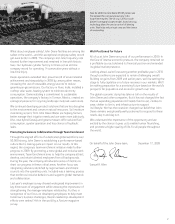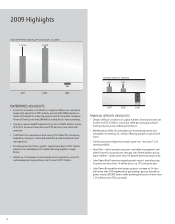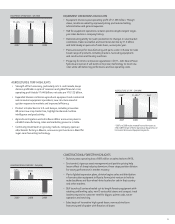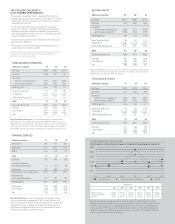John Deere 2009 Annual Report Download - page 16
Download and view the complete annual report
Please find page 16 of the 2009 John Deere annual report below. You can navigate through the pages in the report by either clicking on the pages listed below, or by using the keyword search tool below to find specific information within the annual report.
Equipment Operations outside U.S. and Canada
The equipment operations outside the U.S. and Canada had
an operating profi t of $1,096 million in 2008, compared with
$779 million in 2007. The increase in 2008 was primarily due
to the effects of higher shipment volumes and improved price
realization, partially offset by increases in raw material costs,
increased selling, administrative and general expenses and higher
research and development costs. Net sales were 40 percent
higher in 2008 refl ecting higher volumes, the effect of currency
translation and improvements in price realization. The physical
volume increased 27 percent in 2008 excluding acquisitions,
compared with 2007.
CAPITAL RESOURCES AND LIQUIDITY
The discussion of capital resources and liquidity has been
organized to review separately, where appropriate, the company’s
consolidated totals, Equipment Operations and Financial
Services operations.
CONSOLIDATED
Positive cash fl ows from consolidated operating activities in
2009 were $1,985 million. This resulted primarily from net
income adjusted for non-cash provisions and a decrease in
inventories and trade receivables, which were partially offset by
a decrease in accounts payable and accrued expenses and a change
in accrued income taxes payable/receivable. Cash outfl ows
from investing activities were $57 million in 2009, primarily
due to the purchases of property and equipment of $907 million
and acquisitions of businesses of $50 million, which were
partially offset by proceeds from maturities and sales of market-
able securities exceeding the purchases of marketable securities
by $796 million and collections of receivables and the proceeds
from sales of equipment on operating leases exceeding the cost
of receivables and equipment on operating leases by $94 million.
Cash infl ows from fi nancing activities were $470 million in 2009
primarily due to an increase in borrowings of $1,068 million,
which were partially offset by dividends paid of $473 million.
Cash and cash equivalents increased $2,440 million during 2009.
Over the last three years, operating activities have
provided an aggregate of $6,693 million in cash. In addition,
increases in borrowings were $3,636 million, proceeds from
maturities and sales of marketable securities exceeded purchases
by $1,600 million, proceeds from issuance of common stock
were $411 million, proceeds from sales of fi nancing receivables
were $199 million and the proceeds from sales of businesses
were $119 million. The aggregate amount of these cash fl ows
was used mainly to repurchase common stock of $3,199 million,
purchase property and equipment of $3,042 million, acquire
receivables and equipment on operating leases that exceeded
collections and the proceeds from sales of equipment on
operating leases by $1,792 million, pay dividends to stockholders
of $1,308 million and acquire businesses for $491 million.
Cash and cash equivalents also increased $2,964 million over
the three-year period.
Given the downturn in global economic activity and
capital market disruptions, the sources of funds for the company
have been impacted. However, the company expects to have
suffi cient sources of liquidity to meet its funding needs.
Sources of liquidity for the company include cash and cash
equivalents, marketable securities, funds from operations, the
issuance of commercial paper and term debt, the securitization
of retail notes (both public and private markets) and committed
and uncommitted bank lines of credit. The company’s
commercial paper outstanding at October 31, 2009 and 2008
was $286 million and $2,961 million, respectively, while the
total cash and cash equivalents and marketable securities
position was $4,844 million and $3,189 million, respectively.
On December 4, 2008, John Deere Capital Corporation
(Capital Corporation) and FPC Financial, f.s.b., a wholly-owned
subsidiary of Capital Corporation, elected to continue to
participate in the debt guaranty program that is part of the
Federal Deposit Insurance Corporation’s (FDIC’s) Temporary
Liquidity Guarantee Program (TLGP). During December 2008,
Capital Corporation issued $2.0 billion of fi xed-rate medium-
term notes due June 19, 2012 at a rate of 2.875%, which are
guaranteed by the FDIC under the TLGP. Following that
issuance, the FDIC notifi ed Capital Corporation that it needed
additional review and written determination from the FDIC
prior to issuing additional guaranteed debt. Accordingly,
Capital Corporation submitted documentation to the FDIC
seeking further guidance. Capital Corporation received written
notifi cation from the FDIC that the FDIC denied the request
and that the FDIC had determined that such a denial was
appropriate because the request was inconsistent with the
primary purpose of the TLGP. The notes issued under the TLGP
during December 2008 continue to carry the FDIC guarantee.
During January 2009, Capital Corporation entered into a
revolving credit agreement to utilize bank conduit facilities to
securitize retail notes (see Note 13). At October 31, 2009, this
facility had a total capacity, or “fi nancing limit,” of up to
$2,500 million of secured fi nancings at any time. After a 364
day revolving period, unless the banks and Capital Corporation
agree to renew for an additional 364 days, Capital Corporation
would liquidate the secured borrowings over time as payments
on the retail notes are collected. At October 31, 2009, $1,224
million of secured short-term borrowings was outstanding under
the agreement. During November 2009, Capital Corporation
reduced the capacity under this revolving credit agreement
to $1,500 million and renewed it for an additional 364 days.
In June and October 2009, Capital Corporation issued
$674 million and $727 million, respectively, in retail note
securitization transactions. The retail notes related to these
secured borrowings were eligible collateral under the Federal
Reserve Bank of New York’s Term Asset-Backed Securities
Loan Facility (TALF).
Lines of Credit. The company also has access to bank lines
of credit with various banks throughout the world. Some of the
lines are available to both Deere & Company and Capital
Corporation. Worldwide lines of credit totaled $4,558 million
at October 31, 2009, $4,214 million of which were unused.
17
16
























